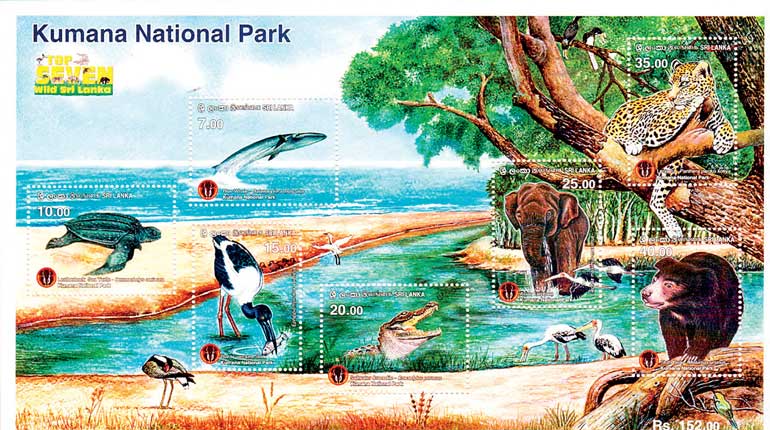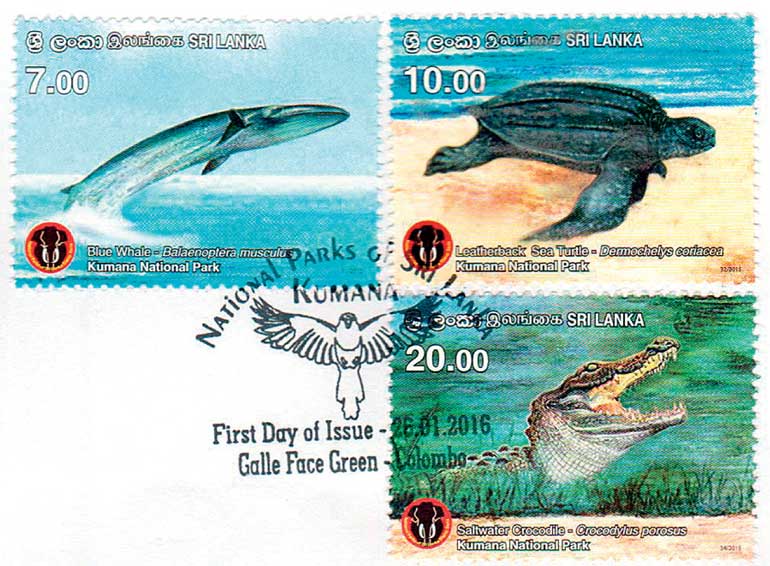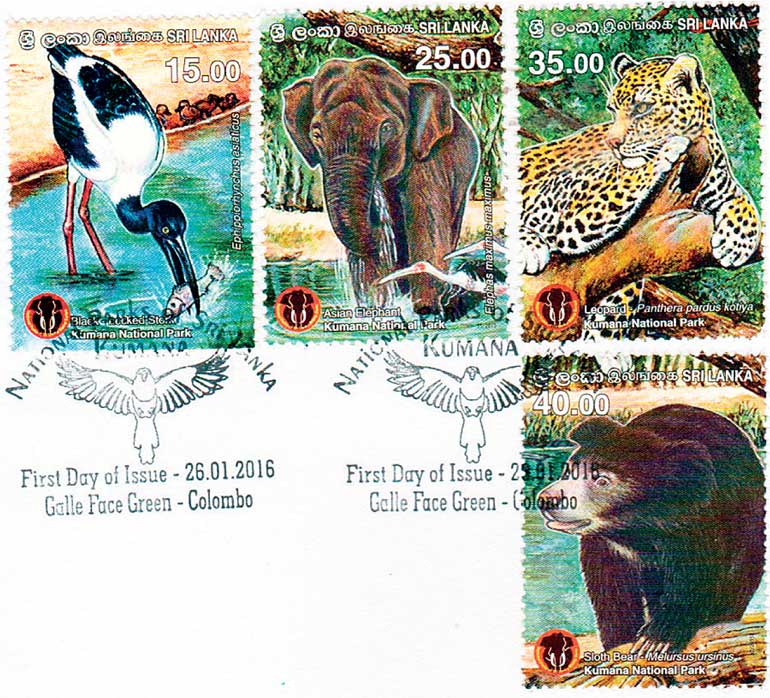Wednesday Feb 12, 2025
Wednesday Feb 12, 2025
Saturday, 4 June 2016 00:00 - - {{hitsCtrl.values.hits}}

By D.C. Ranatunga
Seven animal species in Sri Lanka have been identified by the Department of Wildlife Conservation with features unique to them. They have won recognition as flagship species for conservation and are named ‘Top Seven Wild Sri Lanka’.
Unique anatomical features, dissimilar behaviour, specific distribution and/or adaptations that cannot be imitated are the ‘specials’ identified by the Department in these species.
The ability to spot all these species within a short distance and a short period of time in at least two National Parks is thought to be a major attraction and distinct advantage for conservationists and animal lovers. Kumana in south-east Sri Lanka in close proximity to Yala is one of the Parks. The other has not been indicated in the Department’s narrative in the Stamp Bulletin released along with the set of the Top Seven.
Let’s identify the species featured in the sixth in the series of special issues of stamps on National Parks of Sri Lanka.

Blue Whale
The Blue Whale (Balaenoptera musculus – Sinhala: ‘Talmaha’), seen in the Rs.7 stamp, is one of four species of blue whales of the family Balaenopteridae, present in Sri Lankan waters. The marine mammal grows up to 100 feet (30 meters) in length and upwards of 170 tons in weight and is considered the largest animal ever known to have lived on Earth.
The tongues of blue whales alone can weigh as much as an elephant and their hearts as much as an automobile. They reach these dimensions on a diet composed almost exclusively on tiny shrimplike animals called krill. At certain times of the year a single blue whale consumes about four tons of krill a day.
The blue whale has a broad, flat head and a long, tapered body that ends in wide, triangular flukes.
Blue whales live in all the world’s oceans occasionally swimming in small groups but usually alone or in pairs. The graceful swimmers cruise the ocean at more than five miles an hour (eight km an hour), but accelerate to more than 20 miles an hour (32 km an hour) when they are agitated.
Blue whales are among the loudest animals on the planet. They emit a series of pulses, groans, and moans, and it’s thought that, in good conditions, they can hear each other up to 1,000 miles (1,600 km) away.
The blue whale is in the category of ‘endangered species’ of the World Conservation Union (IUCN) and is a strictly protected animal under the Fauna and Flora Protection Ordinance of Sri Lanka.
In Sri Lanka, whales have been seen in many areas close to the shore mostly in the southern, eastern and north-western coast. Whale watching is fast becoming a popular tourist attraction.
Leatherback Sea Turtle
The Leatherback Sea Turtle (Dermochelys coriacea – Sin: Yodha Muhudu Kesbewa), Rs. 10 stamp, is the largest turtle on Earth, growing up to seven feet (two meters) long and exceeding 2,000 pounds (900 kilograms). These reptilian relics are the only remaining representatives of a family of turtles that traces its evolutionary roots back more than 100 million years. Once prevalent in every ocean except the Arctic and Antarctic, the leatherback population is rapidly declining in many parts of the world.
Leatherbacks can dive to depths of 4,200 feet (1,280 meters)—deeper than any other turtle—and can stay down for up to 85 minutes.
Leatherbacks undertake the longest migrations between breeding and feeding areas of any sea turtle, averaging 3,700 miles (6,000 km) each way. After mating at sea, females come ashore during the breeding season to nest. The night-time ritual involves excavating a hole in the sand, depositing around 80 eggs, filling the nest, leaving a large, disturbed area of sand that makes detection by predators difficult, and finally returning to the sea. The eggs hatch in about 60 to 70 days. The hatchlings dig to the surface of the nest and walk into the sea.
The leatherback turtle is also in the ‘critically endangered list’. Sri Lanka’s Fauna & Flora Protection Ordinance lists it as a ‘strictly restricted reptile’.
Black-necked Stork
The Black-necked Stork (Ephippiorhynchus astatitus – Sin: Gela Kalu Koka) seen in the Rs. 15 stamp is a tall, long-necked wading bird which belongs to the family Ciciniidae. A large bird, it grows up to 130-150cm in height having a 230cm wingspan. The average weight is around four kg. Adults have a glossy bluish-black head, neck flight feathers and tail. They have a bright white back and belly. The sexes are identical but the adult female has a yellow iris while the male’s is brown.
Very silent and unsocial, the Black-necked Storks are seen as single birds, pairs or as family groups. They are in wetland habitats and frequently use freshwater, natural wetlands. A carnivore its diet includes water-birds and a range of aquatic vertebrates and invertebrates such as crabs.
Nest building commences in large and isolated trees during the peak of the monsoon. Nests are made up of sticks and branches, and are lined with rushes, water plants, sometimes with a mud plaster on the edges. Nests extend up to 1-2m in diameter. Usually four eggs are laid. They are dull white in colour and broad oval in shape. The incubation period is about 30 days. The chicks are white in colour and the scapular feathers emerge first.
Widely spread in India and Australia, the Black-necked Stork is a rare resident in Sri Lanka though small family groups have been seen. It belongs to the ‘Near-threatened’ category.

Saltwater Crocodile
Saltwater Crocodile (Crocodylus porosus – Sin: ‘Lavana Diya Kimbula’) in the Rs. 20 stamp is the largest living carnivore reptile of the family Crocodylae. Its distinct feature is the immense body size. The length of the male can be up to 6.7m and the weight 2,000kg.The females are smaller and do not exceed three m in length. While young ones are yellow in colour with black stripes and spots, the adult is much darker. The ventral surface is white or yellow.
A formidable and opportunistic carnivore, the saltwater crocodile takes almost any animal that enters his territory – from fish to reptiles, birds and animals. They are able to survive for long periods with little food. The larger the animal, the greater is the variety of its diet.
Usually they reside in mangrove swamps, estuaries, deltas, lagoons and lower stretches of rivers. They are able to travel long distances.
The female is much smaller than the male and lays 40 to 60 eggs. She guards the nest for 70 to 98 days.
Once widespread throughout Southeast Asia, in Sri Lanka this crocodile type is now limited to protected areas extending up to coastal habitats. They meet with accidental death being caught in fishing nets.
Asian Elephant
The Asian Elephant (Elaphas maximus maximus – Sin: Asiyanu Aliya), Rs. 25 stamp, belongs to the family Elephantidae – one of three in Asia. The size of the body (up to 2.7m for males and 2.4m for females) and the trunk are their most prominent features. Weighing an average three tons large bulls can grow up to six tons. They are highly intelligent and self-aware. Tamed elephants can work under instructions.
In addition to cultivated secondary forests and scrub lands, they inhabit grasslands, tropical and semi-evergreen forests and dry thorn forests.
Classified as mega herbivores, the Asian elephant consumes up to 170-220kg of pant matter per day. It is recorded as feeding on over 130 different plant species and drinks 70-150 litres of water per day. Scraping the soil is a usual habit in search of minerals.
The elephants behave as a family unit. Adult females and calves move about together as groups but adult males move away from their mothers upon reaching adolescence. Bull elephants may be solitary or form temporary ‘bachelor’ groups. They use infrasound to communicate.
When the male is ‘in musth’ between the age of 10-20 years it becomes very aggressive and is ready to mate. Once they do, the gestation period is 18 to 22 months with the female usually giving birth to one calf.
Leopard
The Leopard (Panthera padus kotiya – Sin: Diviya) in the Rs. 35 stamp belongs to the Felidaeis family. The adaptability to different habitats from rainforest to desert terrain and its opportunistic hunting behaviour greatly contribute to their successful survival in diverse landscapes. It runs at speeds of 60km and can climb trees even while carrying a heavy carcass. It is also a powerful swimmer.
Leopards are agile and stealthy predators and are able to attack large prey using their massive skulls and powerful jaws. They are versatile hunters and have a broad food preference. At least 92 prey species have been recorded as their diet.
They are elusive, solitary and largely nocturnal. Females give birth in a cave, crevice among boulders, hollow trees or thicket. The gestation period is from 90 to 150 days. Cubs are born with closed eyes which open within four to nine days after birth. Around three months after, the young begin to follow the mother on hunts. By the time it is one year, the young can fend prey for themselves but continue to be with the mother for 18 to 24 months.
Leopards are in the ‘near threatened’ category and are protected in Sri Lanka.
Sloth Bear
The Sloth Bear (Melursus ursinus – Sin: Valaha) on the Rs. 42 stamp is a termite eating mammal of the Ursidae family, found in the Indian subcontinent. The black shaggy coat is the main feature of the sloth bear who is distinguished from the Asian Black Bear by the lankier build, longer, shaggier coats, pale muzzles and white claws. Males weigh up to 130kg on average while the female is around 110kg. The height is 60-90cm at shoulder. Females are smaller.
Sloth bears prefer to be in protected areas with thickets of scrub providing cover and shade. They have a specially adapted lower lip and palate to access the food source, mainly termites, which are sucked up through the muzzles. The sensitive and flexible nose helps in fashioning its lips into a tube like form so that the lips function like a vacuum cleaner nozzle and facilitates sucking termites. The diet is supplemented with fruits, bees’ honey combs and plants.
Galloping faster than running humans, they are excellent climbers, even the cubs. They scratch trees with their forepaws and rub against them with their flanks.
The breeding season is all year round. Females gestate for 210 days. Litters usually consist of one or two cubs.
Declared as ‘vulnerable’ by the World Conservation Union, the sloth bear is protected in Sri Lanka.
Source: Dept. of Wildlife Conservation
Located at the southernmost corner of the Eastern Province, Kumana is the most picturesque area of the dry zone coastline of Sri Lanka. The very name Kumana conjures visions of our abundant wealth of avifauna in all its plumed splendour.
The famous Kumanavillu – a mangrove swamp of about 5,000 acres where water birds nest – lies amidst abundant wildlife-filled plains and jungle, archaeologically rich outcrops of rick with their many caves and inscriptions, and miles of unexplored golden beaches.
The gently flowing waters of the Kumbukkan Oya that form a boundary on the southern side, contrasts with the roar of the surface of the sea coast that flanks Kumana to the east. A succession of salt water lagoons along the coast, each surrounded by extensive plains are a treat to wildlife lovers.
The lagoons attract numerous sandpipers, plovers, ducks and waders during the North East monsoon and the plains are specked with deer, buffalo and wild pig. Large crop-outcrops of fantastic shapes rise from the flat terrain and ensconce habitable drip-ledged caves, some with rock inscriptions of the pre-Christian era.
In and around the extensive plains that surround the lagoons one could also see elephant and leopard. As one traverses the glades and waterholes sambur are met singly or in groups. In the rocky outcrops, the sloth bear could be seen. Mainly a nocturnal beast, during the ‘palu’ season of June and July, it ventures out during the day to feed on the luscious berries. The leopard is met in the rocky areas where it seeks the shelter of the caves.
As dusk falls and the diurnal animals take their rest, the jungle becomes active again, the nocturnals are out, foraging for their foods. The mongoose and civet cat tread the same paths that were used by other animals during the day. And so it goes on from dawn to dusk to dawn...
– ‘Handbook for the Ceylon Traveller’ – Studio Times publication
Discover Kapruka, the leading online shopping platform in Sri Lanka, where you can conveniently send Gifts and Flowers to your loved ones for any event including Valentine ’s Day. Explore a wide range of popular Shopping Categories on Kapruka, including Toys, Groceries, Electronics, Birthday Cakes, Fruits, Chocolates, Flower Bouquets, Clothing, Watches, Lingerie, Gift Sets and Jewellery. Also if you’re interested in selling with Kapruka, Partner Central by Kapruka is the best solution to start with. Moreover, through Kapruka Global Shop, you can also enjoy the convenience of purchasing products from renowned platforms like Amazon and eBay and have them delivered to Sri Lanka.
Discover Kapruka, the leading online shopping platform in Sri Lanka, where you can conveniently send Gifts and Flowers to your loved ones for any event including Valentine ’s Day. Explore a wide range of popular Shopping Categories on Kapruka, including Toys, Groceries, Electronics, Birthday Cakes, Fruits, Chocolates, Flower Bouquets, Clothing, Watches, Lingerie, Gift Sets and Jewellery. Also if you’re interested in selling with Kapruka, Partner Central by Kapruka is the best solution to start with. Moreover, through Kapruka Global Shop, you can also enjoy the convenience of purchasing products from renowned platforms like Amazon and eBay and have them delivered to Sri Lanka.